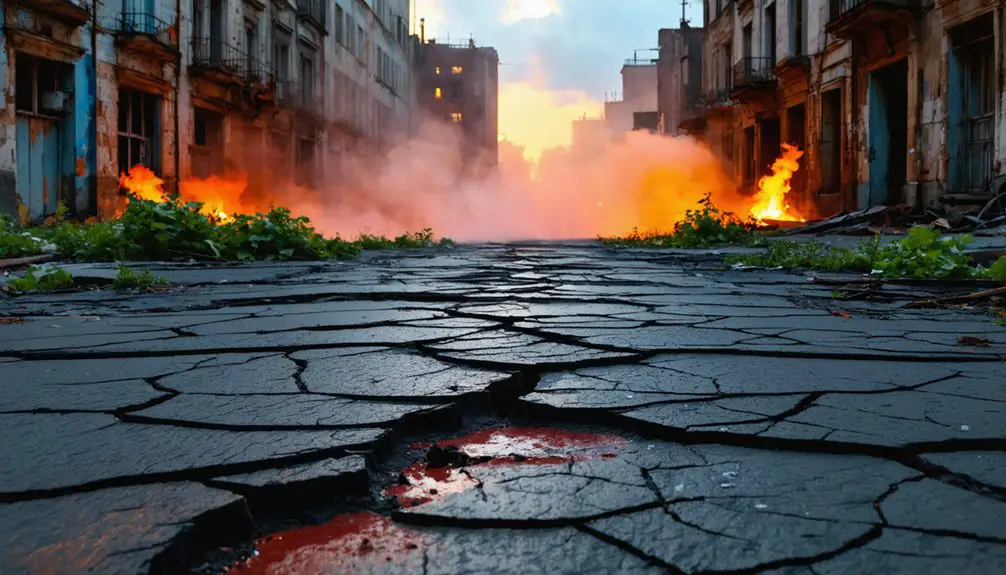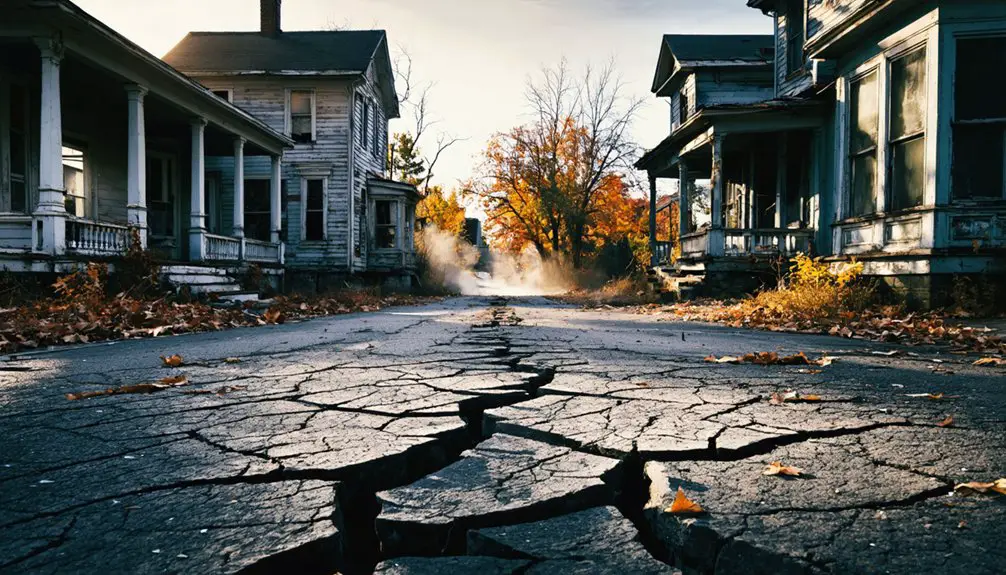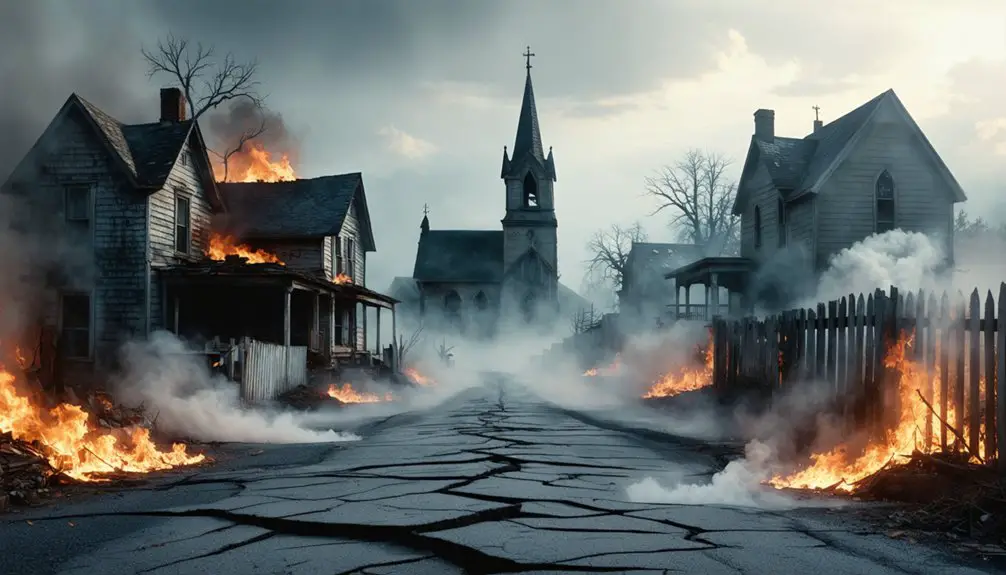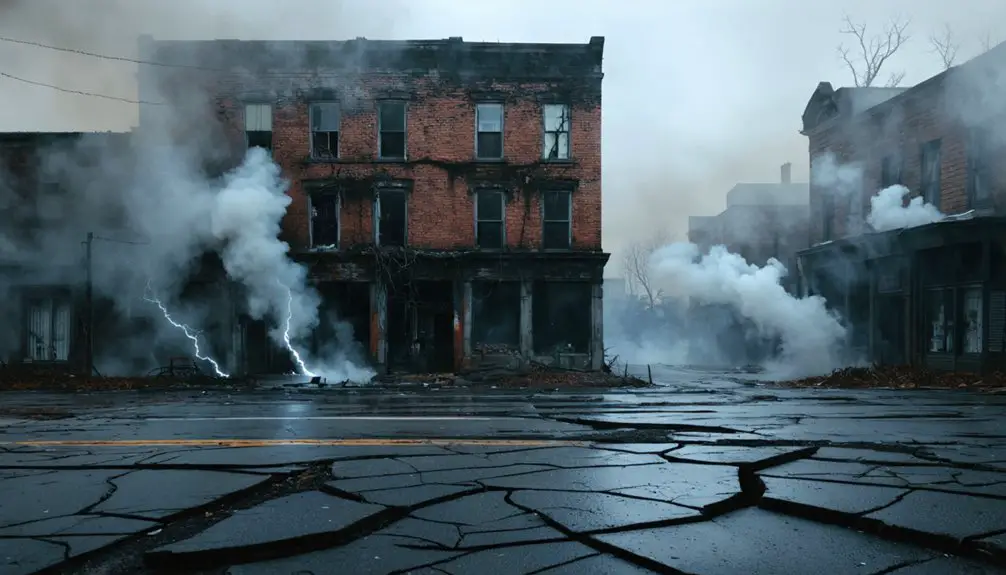Centralia’s story reveals how industrial negligence transformed a thriving coal town into America’s longest-burning ghost town. You’ll find an underground inferno that’s raged since 1962, when a trash fire ignited abandoned mine shafts beneath the town. The disaster forced most residents to evacuate as toxic gases, ground collapses, and environmental damage made the area uninhabitable. Today, smoke still rises from ground fissures while nature slowly reclaims the haunting landscape – a stark warning about the true cost of resource exploitation.
Key Takeaways
- Centralia became a ghost town after an underground mine fire started in 1962, which continues burning beneath the town today.
- The town’s population dropped from 1,200 to just five residents as toxic gases and ground instability forced mass evacuations.
- Most buildings were demolished, leaving only abandoned streets, scattered foundations, and smoke rising from ground fissures.
- The underground fire spans 3,700 acres across an 8-mile stretch, releasing deadly gases and creating dangerous sinkholes.
- Despite official warnings and environmental hazards, the abandoned town attracts urban explorers drawn to its eerie landscape.
The Birth of a Mining Town: From Native Land to Coal Country
The transformation of Centralia from indigenous territory to a coal mining hub spans less than a century, marking one of Pennsylvania’s most dramatic ecological shifts.
In mere decades, Centralia’s pristine indigenous lands morphed into a stark industrial landscape, forever altering Pennsylvania’s environmental legacy.
You can trace this change to 1749, when Native American tribes sold their ancestral lands for £500, severing centuries of indigenous heritage and land rights in the Susquehanna watershed region.
The area’s destiny shifted dramatically when Robert Morris acquired the land in 1793, followed by Stephen Girard’s purchase in 1830.
The Reading Road connected the growing settlement to Fort Augusta in 1770, establishing vital trade routes.
After discovering anthracite coal deposits, the Locust Mountain Coal and Iron Company transformed the wilderness into an industrial center.
The construction of the Mine Run Railroad in 1854 revolutionized coal transport and accelerated the town’s industrial development.
Underground Wealth: The Anthracite Coal Mining Era
You’ll find Centralia’s rich anthracite coal deposits transformed a rural landscape into a bustling industrial hub after 1856, when the first mines at Locust Run and Coal Ridge began extracting the valuable “hard coal.”
The town’s explosive growth attracted waves of European immigrants seeking work, while the Lehigh and Mahanoy Railroad’s arrival in 1865 connected Centralia’s underground wealth to keen Eastern markets.
These economic opportunities came at a steep social cost, as violent conflicts erupted between mine operators and labor groups like the Molly Maguires, who fought for better working conditions in the dangerous mines. The region represented the only anthracite reserves found within the United States, making it a crucial resource for industrial development. The area became so significant that multiple disambiguation pages were needed to distinguish it from other places named Centralia.
Mining Wealth Fuels Growth
Beneath Centralia’s surface lay vast deposits of anthracite coal that would transform this Pennsylvania borough into a thriving mining town between 1856 and 1863.
You’ll find that five major mines, including the Locust Run and Centralia Mine, sparked unprecedented economic prosperity as they tapped into the rich Llewellyn Formation.
The mining boom didn’t just extract coal – it extracted cultural riches too. Waves of immigrant workers from across Europe poured into Centralia, bringing their traditions, languages, and determination.
Their influence shaped everything from local cuisine to community values. The Lehigh and Mahanoy Railroad’s arrival in 1865 connected this diverse workforce to broader markets, while mining revenues funded new homes, schools, and churches. The town’s success attracted a population of 1,200 who formed strong community bonds in this prosperous mining hub.
Labor Strife Shapes Town
While Centralia’s coal mining wealth fueled its growth, violent labor conflicts transformed the town’s social landscape throughout the 1860s. The secretive Molly Maguires led early labor unionization efforts, fighting against harsh working conditions through intimidation and violence, including the murder of town founder Alexander Rae in 1868.
You’ll find the turning point came with the landmark 1902 Anthracite Coal Strike, when 147,000 miners launched mining protests that caught national attention. Coal powered America’s industrial revolution, making mining towns like Centralia essential to the nation’s economic growth.
President Theodore Roosevelt’s unprecedented intervention forced mine owners to grant workers better wages and shorter hours. This victory strengthened the labor movement, but it couldn’t erase the human toll of mining – black lung disease, cave-ins, and grinding poverty had already scarred generations of Centralia’s miners and their families. Today, the town stands nearly empty with just five permanent residents remaining, a stark reminder of its turbulent past.
Dark Days of the Molly Maguires
During the turbulent 1860s, Centralia’s coal-rich landscape became a battleground for the Molly Maguires, a secret society of Irish immigrants who fought against harsh mining conditions and labor exploitation.
You’ll find their legacy deeply embedded in the town’s soil, where violent activism shaped early labor unionism in Pennsylvania’s anthracite region.
The Mollies’ most notorious act came in 1868 with the murder of Alexander W. Rea, Centralia’s founder and mine supervisor.
This watershed moment intensified the struggle between workers and mine operators, leading to a fierce crackdown.
A local priest named Father McDermott allegedly placed a curse on Centralia after being assaulted, adding to the town’s dark history.
By 1878, about twenty suspected members faced the gallows, effectively ending their influence.
Yet their impact on labor rights and resource management persisted, as descendants of these controversial figures remained in Centralia until the 1980s, carrying whispers of their forebears’ desperate fight for justice.
Their downfall was accelerated by Pinkerton detective McParlan, whose undercover work and testimony led to numerous convictions.
The Fatal Spark: How the 1962 Mine Fire Started
As flames from a routine trash burn pierced through an inadequate clay barrier at Centralia’s landfill in May 1962, they ignited one of America’s most devastating environmental catastrophes.
In defiance of Pennsylvania’s 1958 fire safety laws, local officials authorized a pre-Memorial Day cleanup that would forever alter the region’s landscape. The volunteer fire company initiated the burning, intending to manage the garbage dump’s odors before the holiday.
- The fire breached the landfill’s incomplete protective barrier, finding a 15-foot-wide hole that led straight into abandoned mine tunnels.
- Underground temperatures soared past 1,000°F, releasing toxic gases throughout the mine network.
- The inferno spread rapidly through hundreds of miles of coal-rich tunnels beneath the town.
- Landfill negligence and rushed waste management transformed a thriving mining community into a stark reminder of industrial carelessness.
Burning Earth: The Science Behind the Eternal Fire

You’ll find Centralia’s underground inferno sustained by an intricate network of coal seams stretching 8 miles beneath the surface, where temperatures once reached a scorching 315°C.
As the fire consumes these carbon-rich deposits through a self-perpetuating cycle of heat and combustion, it releases toxic gases like carbon monoxide and sulfur compounds through surface vents and fissures.
The environmental impact extends beyond immediate safety concerns, as the fire has already consumed 160 hectares of coal reserves while causing ground subsidence and contaminating local groundwater systems.
Underground Coal Seam Ignition
While many coal seam fires occur naturally, Centralia’s underground inferno began in May 1962 through human negligence when burning trash in an abandoned strip mine ignited the Buck Mountain Coal Bed below.
Poor fire prevention practices and inadequate coal management led to this devastating environmental catastrophe when hot ash found its way through incomplete clay barriers into the vast network of abandoned mine tunnels.
- The fire penetrated deep coal seams up to 300 feet below ground
- It now spans 3,700 acres across an 8-mile stretch of rich anthracite deposits
- Underground temperatures exceed 1,000°F, making containment impossible
- The continuous oxygen flow through mine tunnels keeps the fire burning indefinitely
You’ll find this preventable disaster serves as a stark reminder of how improper waste disposal can transform valuable energy resources into an unstoppable environmental threat.
Heat Vents and Gases
Deep beneath Centralia’s surface, an intricate network of heat vents has transformed the landscape into a toxic wasteland of sulfurous steam and deadly gases.
You’ll find these vents, reaching depths of 20 feet or more, spewing a lethal cocktail of carbon monoxide, methane, and sulfur compounds into the air you breathe.
The heat vent formation continues to expand as the underground fire spreads, creating new fissures and destabilizing the ground beneath your feet.
You can’t miss the scorched earth surrounding these vents, where extreme temperatures have killed all vegetation and altered the soil’s chemistry.
The gas toxicity poses severe health risks, with carbon monoxide levels matching those of underground coal fires.
Modern sensors track these deadly emissions, warning of the persistent danger that’s expected to continue for centuries.
Environmental Impact Assessment
The environmental toll of Centralia’s underground inferno extends far beyond its visible heat vents, reaching deep into the region’s ecological fabric.
You’ll find a wasteland where soil disruption has fundamentally altered the land’s ability to sustain life, while toxic gas emissions continue to poison both air and groundwater.
- Underground temperatures have destroyed essential microbial ecosystems, leaving the soil sterile and vulnerable to erosion.
- Greenhouse gas emissions, including CO2 and methane, pour from countless fissures, contributing to climate change.
- Heavy metals and pollutants have contaminated local water supplies, creating a ripple effect throughout the food chain.
- The fire consumes millions of tons of coal annually, permanently depleting this non-renewable resource while releasing mercury and other toxins into the atmosphere.
Ghost Streets and Empty Houses: The Town’s Abandonment

Since a devastating underground mine fire ignited in 1962, Centralia’s transformation from bustling coal town to abandoned wasteland stands as a stark reminder of industrial mismanagement’s ecological impact.
Today, you’ll find ghostly remnants of what was once a thriving community, with nature steadily reclaiming the abandoned infrastructure.
Where homes and businesses once stood, you’ll now discover crumbling foundations and buckled streets consumed by wildflowers and saplings.
The town’s abandoned infrastructure tells a haunting story – over 1,100 demolished homes, isolated row houses requiring structural support, and roads warped into asphalt walls by the relentless heat below.
While a few determined residents remain in government-owned homes, most of Centralia has surrendered to wildlife and vegetation, creating an eerie blend of urban decay and natural rebirth above the still-burning underground inferno.
Life in a Dying Town: Stories of Those Who Stayed
Among Centralia’s crumbling streets and empty lots, a handful of determined residents still call this hazardous landscape home. The remaining residents, bound by life estate agreements with Pennsylvania officials, navigate a world where underground fires have transformed their once-thriving mining town into an environmental battleground.
Despite the government’s use of eminent domain and the discontinuation of basic services, these stalwart individuals refuse to abandon their ancestral properties.
Even as their town crumbles and services vanish, Centralia’s last residents stand firm, refusing to relinquish their family legacy.
- Toxic gases seep through scorched earth while metal vents dot the landscape, releasing pressure from the burning coal seams below.
- Homes stand isolated among vacant properties, cut off from former neighborhoods by collapsed infrastructure.
- Daily life requires careful navigation around unstable ground and limited access to essential services.
- Each resident’s passing means another property returns to state control, slowly erasing the last traces of human habitation.
The Curse of Father McDermott and Other Local Legends

Deep beneath Centralia’s scarred landscape lies a dark history intertwined with supernatural beliefs, centered around Father Daniel McDermott’s legendary curse.
After three Molly Maguires assaulted him, the priest prophesied that only St. Ignatius Church would remain standing while the rest of the town would face destruction.
The curse gained credibility as violence erupted through the coal-mining community, culminating in the mayor’s murder and subsequent hangings of Molly Maguire members.
Though St. Ignatius Church was eventually demolished in 1997 due to the mine fire’s toxic fumes, local legends persist about the curse’s fulfillment.
You’ll find that many residents connect the supernatural with the town’s ecological disaster – where smoke still rises from the earth, and only eight buildings remain standing, evidence of Father McDermott’s dark prophecy.
Environmental Impact and Lasting Legacy
You’ll find Centralia’s toxic legacy etched into every aspect of its ravaged environment, from noxious gases seeping through ground fissures to contaminated soil and water systems that continue to poison the ecosystem.
The underground fire’s destructive force has carved a network of dangerous sinkholes and unstable terrain, making large swaths of land permanently uninhabitable and disrupting natural wildlife habitats.
Despite recent ecological restoration efforts, including the planting of apple trees in 2021, the ongoing underground combustion continues to challenge meaningful environmental recovery and serves as a stark reminder of industrial disaster’s lasting impact.
Toxic Legacy Lives On
The toxic legacy of Centralia’s underground mine fire persists as one of America’s worst environmental disasters, releasing dangerous gases and contaminating the surrounding ecosystem since 1962.
The toxic pollution has transformed a once-thriving community into a stark reminder of industrial negligence and environmental mismanagement.
- You’ll find carbon monoxide and volatile organic compounds seeping through soil fissures, creating deadly air quality conditions.
- The fire’s intense heat continues scorching the land, destroying wildlife habitats and preventing natural regeneration.
- Groundwater contamination threatens nearby waterways, while soil chemistry alterations make agriculture impossible.
- Despite community resilience, the spreading fire creates new zones of ecological trauma, expanding its destructive reach.
These ongoing environmental impacts serve as a powerful warning about the true cost of industrial shortcuts and inadequate oversight.
Underground Hazards Still Threaten
Building upon the toxic legacy, Centralia’s underground mine fire continues releasing an array of deadly hazards that make the area increasingly treacherous.
You’ll find ground stability severely compromised, with the constant risk of sudden sinkholes and surface collapses threatening anyone who ventures into the fire zone.
The persistent danger extends beyond visible threats.
Underground temperatures exceeding 1,000 degrees Fahrenheit have altered soil chemistry and hydrology, while toxic gases seep through ground fissures.
These conditions have devastated local ecosystems, poisoning groundwater and destroying vegetation.
Despite decades of attempted interventions, the labyrinth of burning mine tunnels defies control efforts, creating an expanding zone of destruction.
The Pennsylvania Department of Environmental Protection actively warns against entering this unstable terrain, where the earth itself has become unreliable.
Modern Day Centralia: A Tourist’s Forbidden Paradise
Despite official warnings and grave environmental hazards, modern-day Centralia stands as a haunting representation to industrial negligence and environmental catastrophe.
While tourist safety remains a critical concern, the abandoned town’s allure continues drawing urban exploration enthusiasts to its smoke-filled streets and haunting landscape.
- You’ll witness smoke plumes rising from ground fissures, serving as stark reminders of the unstoppable inferno beneath your feet.
- You’re walking through a town where only five residents remain, with nature slowly reclaiming abandoned structures.
- You’ll spot metal vent pipes scattered across the terrain, releasing toxic gases from the underground blaze.
- You’re exploring at your own risk, as the DEP strictly forbids entry due to potential ground collapses and lethal gas exposure.
Frequently Asked Questions
Can You Legally Explore Centralia’s Abandoned Buildings and Streets Today?
You’ll face strict legal restrictions if you attempt urban exploration of abandoned buildings – they’re private property. You can walk public streets, but stay alert for toxic fumes and unstable ground.
What Happened to the Cemetery and Buried Remains in Centralia?
You’ll find the Odd Fellows Cemetery preserved at its original burial site despite the underground mine fire, with intact graves and metal headstones still standing behind the iron fence near Route 61.
How Much Did Property Owners Receive in Government Buyouts?
Like a fire sale from hell, you’d have received varying government compensation through property buyouts – averaging portions of the $42 million fund ($127 million today) allocated for relocating displaced residents.
Are There Any Documented Deaths Directly Caused by the Mine Fire?
You’ll find no documented mine fire fatalities directly caused by Centralia’s underground inferno, though serious health risks persist through toxic gases and unstable ground that could prove lethal to visitors.
What Temperature Does the Ground Reach in Centralia’s Hottest Areas?
Picture scorched earth steaming: you’ll find ground temperatures reaching up to 900°F in the hottest surface areas, while underground heat sources can blaze even hotter, soaring to a staggering 1,350°F beneath your feet.
References
- https://pabucketlist.com/the-rise-and-fall-of-centralia-pas-toxic-ghost-town/
- https://www.legendsofamerica.com/centralia-pennsylvania/
- https://www.youtube.com/watch?v=Qj5LjacccJ0
- https://www.jeffreydonenfeld.com/blog/2009/12/exploring-the-ghost-town-of-centralia-pennslvania/
- https://en.wikipedia.org/wiki/Centralia
- https://www.centraliapa.org/history-centralia-pa-before-1962/
- https://vocal.media/history/this-abandoned-pennsylvania-town-is-one-of-the-most-contaminated-in-the-state
- https://architecturalafterlife.com/2015/02/wandering-through-silent-hill/
- https://guides.libraries.psu.edu/anthracite
- https://scholarship.shu.edu/cgi/viewcontent.cgi?article=1072&context=locus



